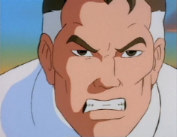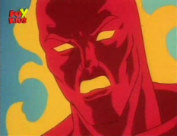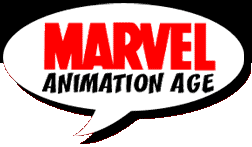|
|
Interviews - Boyd Kirkland
How did you get the job boarding for each of these episodes and what
specifically did you do?
Larry Houston, the showís producer, is a friend who Iíve worked with off
and on over the years, and he asked if Iíd help him out on the show. I
was still at Warner Bros. at the time, so drew the boards as a freelance
job. Typically, a half hour show is divided into three acts, and a
different artist draws each act in order to get it done on a very short
schedule. Storyboards function as a blueprint for the show, setting up
all of the staging, scene transitions, camera moves, and
acting/expressions on the characters. Often, backgrounds and props are
designed based on what the storyboard artist draws, as well.
 Which was your favorite episode to work on Fantastic Four? Which was your favorite episode to work on Fantastic Four?
I enjoyed them all, as they were based on the Kirby/Lee comics I loved
as a kid in the 60ís. But I particularly enjoyed drawing the episode
with Doctor Doom stealing the Silver Surferís power, and his encounter
with the Thing in Central Park.
As Hulk didnít have his own show at the time this episode was in
production, how difficult is it to properly develop a hugely popular
character in a mere 20 minutes? Is it all in the writing?
Of course, the writing really determines the story. As the artist, you
just try to convey the power and pathos of the characters in how you
pose them and stage the scenes. In live action films, the body language,
lighting, camera angles and movement all play important roles in
affecting the audienceís involvement and emotional response, and they do
the same thing in animation.
Being that the show aired in the mid 90ís, how much did you have to
worry about Broadcast Standards and Practices when drawing out the fight
scenes?
 Having already done a lot of this stuff, I knew where the boundaries
were, for the most part. But you always try to push it, to go where the
scene demands, and then leave it to the censors to pull it back, if
necessary. Of course, post-Batman, we were able to go further than had
been previously allowed. The pendulum has been swinging back the other
way in the last few years, unfortunately. Having already done a lot of this stuff, I knew where the boundaries
were, for the most part. But you always try to push it, to go where the
scene demands, and then leave it to the censors to pull it back, if
necessary. Of course, post-Batman, we were able to go further than had
been previously allowed. The pendulum has been swinging back the other
way in the last few years, unfortunately.
Youíve previously worked with both The Fantastic Four and The Hulk in
earlier shows from several years ago. Which did you prefer the 90ís
version or the 70ís show?
In the late 70ís and early 80ís, I drew layouts for the shows, so didnít
really have much effect on the tone or content of them. But as an
artist, it was a real kick to be drawing characters I loved from the
comics. Of course, the earlier shows were much softer, and less accurate
to the comics due to network restrictions, and often had less production
value, with more limited animation, canned music and sound effects, etc.
The biggest kick was drawing layouts on the Depatie-Freleng FF show
because Jack Kirby was drawing the storyboards. He didnít quite have a
handle on scene cutting or continuity, etc., so we had to fix those
things, but his drawings were just so powerful and great to look at,
like his comics, they were a great inspiration. The best use of his
talents in animation was as a designer for the Thundarr series, which I
also drew layouts for on the first season.
What do you think about the overall outcome of the 90ís Fantastic
Four show?
 I really disliked the first season of the show, but it really turned
around when Larry took over on the second season. I had been asked by
Marvel to produce the first season of both the FF and Iron Man, but
turned it down when I saw what they were planning to do. The later stuff
at least had some decent storytelling and production values. Larry was
also a big fan of the 60ís comics, and it showed. I really disliked the first season of the show, but it really turned
around when Larry took over on the second season. I had been asked by
Marvel to produce the first season of both the FF and Iron Man, but
turned it down when I saw what they were planning to do. The later stuff
at least had some decent storytelling and production values. Larry was
also a big fan of the 60ís comics, and it showed.
Youíve worked on a vast majority of superhero shows, doing an incredibly
varied amount of tasks. Writing, producing, directing, storyboarding and
layouts for the likes of Batman, Hulk, Spider-Man, The X-Men, with The
Avengers soon to follow. What made the FF stand out?
I always loved the FF comic when Kirby was drawing it. He was creatively
at the peak of his career, putting out a non-stop stream of incredible
characters and mind-blowing cosmic concepts that everyone since has
mined, but never topped. Plus, Stan Lee made the FF a family, investing
them with great humor, affection and pathos that was just great
character-driven storytelling. Brad Birdís Incredibles movie owes them a
great debt of gratitude.
The staff at Marvel Animation Age would like to say a big thanks
to Boyd for the interview!
|
|
